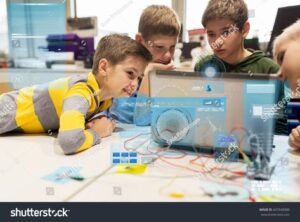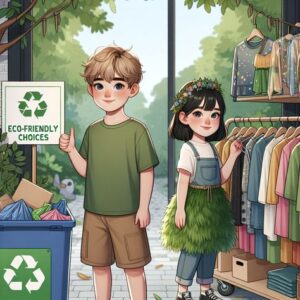Uncategorized
The Role of Technology in Revolutionizing Kids’ Fashion
The fashion industry has witnessed significant transformations over the years, and kids’ fashion is no exception. Technology has become a powerful catalyst in revolutionizing how children’s clothing is designed, produced, marketed, and even worn. From smart textiles to AI-driven personalization, tech innovations are reshaping kids’ fashion into a dynamic, efficient, and sustainable domain.
Here’s a closer look at how technology is redefining kids’ fashion and its implications for parents, designers, and the industry.
1. Smart Textiles: Functionality Meets Innovation

Smart textiles are one of the most groundbreaking advancements in kids’ fashion, offering features that go beyond aesthetics.
- Temperature-Regulating Fabrics: These fabrics adapt to the wearer’s body temperature, keeping kids comfortable in fluctuating weather conditions.
- Stain-Resistant Materials: Nanotechnology has enabled the development of fabrics that repel liquids, making clothes easier to clean and maintain.
- Wearable Tech Integration: Clothes embedded with sensors can monitor vital signs like temperature, heart rate, or sleep patterns, ideal for infants and young children.
- UV Protection: Advanced textiles with built-in UV protection shield kids from harmful sun exposure during outdoor activities.
Smart textiles make clothing more functional and tailored to children’s active and sensitive lifestyles.
2. 3D Printing: Customization at Its Best
3D printing technology has opened new possibilities for creating unique and customized clothing for kids.
- Rapid Prototyping: Designers can quickly create prototypes of new designs, reducing the time to market.
- Customization: Parents can order tailored clothes for their children, from size adjustments to unique patterns or designs.
- Sustainability: 3D printing reduces fabric waste by using only the exact amount of material needed for a garment.
This technology caters to the growing demand for personalized and eco-friendly kids’ fashion.
3. Virtual Try-Ons: Shopping Made Easy
Augmented reality (AR) and virtual try-on technologies have revolutionized the shopping experience for parents.
- Fit Prediction: Using AR, parents can visualize how a piece of clothing will fit their child without physical trials, saving time and effort.
- Interactive Shopping: Kids can participate in the process by virtually trying on outfits, making shopping more engaging and fun.
- Reduced Returns: Accurate virtual sizing tools reduce the chances of ill-fitting clothes, decreasing returns and waste.
Virtual try-ons bridge the gap between online and in-store shopping, providing convenience and accuracy.
4. AI-Driven Personalization
Artificial intelligence (AI) is transforming kids’ fashion by offering hyper-personalized shopping experiences.
- Style Recommendations: AI-powered platforms analyze past purchases, preferences, and sizes to suggest suitable outfits for kids.
- Dynamic Sizing: AI tools can predict a child’s growth trajectory, helping parents choose clothes that accommodate future growth spurts.
- Custom Designs: Parents can work with AI-based tools to design bespoke outfits tailored to their child’s personality or specific needs.
AI ensures a seamless, customized experience for both parents and children.
5. Sustainability Through Tech Innovations
Sustainability has become a significant focus in kids’ fashion, and technology plays a pivotal role in promoting eco-friendly practices.
- Recycled Materials: Advanced processes turn waste materials, like plastic bottles, into high-quality fabrics for kids’ clothing.
- Blockchain Transparency: Blockchain technology allows parents to track the origins of their child’s clothes, ensuring ethical and sustainable production practices.
- Energy-Efficient Production: Automated manufacturing processes powered by AI reduce energy consumption and waste in production.
Tech-driven sustainability ensures that kids’ fashion aligns with environmental and ethical standards.
6. Interactive and Educational Clothing
Technology has introduced interactive elements into kids’ clothing, combining fashion with learning and play.
- Clothes with Embedded QR Codes: Scannable codes on garments link to stories, games, or educational content, turning outfits into learning tools.
- Motion-Activated Lights and Sounds: Jackets or shoes that light up or produce sounds encourage active play and creativity.
- Gamified Wearables: Smart clothing that tracks movement or rewards activity promotes health and fitness among kids.
Interactive clothing blends functionality with entertainment, keeping kids engaged and active.
7. Automation in Manufacturing
The integration of robotics and automation has streamlined the production of kids’ clothing.
- Precision Cutting: Automated cutting machines ensure fabric is used efficiently, reducing waste.
- Faster Production: Robotics accelerate manufacturing timelines, allowing brands to respond quickly to market demands.
- Cost Efficiency: Automation reduces labor costs, making high-quality kids’ clothing more accessible to consumers.
Automation enhances efficiency and sustainability in the kids’ fashion industry.
8. Digital Marketing and Social Media Trends

Technology has reshaped how kids’ fashion is marketed and sold.
- Social Media Influence: Platforms like Instagram and TikTok feature kids’ fashion influencers and trends, shaping purchasing decisions.
- E-Commerce Platforms: User-friendly online stores offer parents a convenient way to explore and buy kids’ fashion.
- Virtual Fashion Shows: Brands use digital runways and livestream events to showcase their latest collections to global audiences.
Tech-driven marketing strategies make kids’ fashion more visible and accessible to modern families.
9. Data Analytics for Trend Forecasting
Big data and analytics tools help brands predict and respond to trends in kids’ fashion.
- Understanding Consumer Behavior: Data analysis reveals parents’ preferences, from fabric choices to price points.
- Identifying Popular Trends: Tools track which colors, patterns, and styles resonate most with consumers.
- Efficient Inventory Management: Predictive analytics prevent overproduction, aligning supply with demand.
Data-driven insights help brands deliver better products while minimizing waste.
10. Enhanced Safety Features
Technology has introduced safety-focused innovations in kids’ clothing.
- GPS-Enabled Wearables: Smart garments with GPS trackers provide parents peace of mind, especially during outings.
- Fire-Resistant Fabrics: Advanced materials reduce risks during specific activities, ensuring children’s safety.
- Chemical-Free Production: Tech innovations in fabric treatment eliminate harmful chemicals, protecting kids’ skin.
Safety-enhanced clothing demonstrates how technology addresses parents’ concerns without compromising style.
Conclusion
Technology has profoundly impacted kids’ fashion, making it smarter, more sustainable, and highly personalized. From smart textiles to AI-driven designs, these advancements cater to the needs of modern families while ensuring comfort, functionality, and style. As technology continues to evolve, it will undoubtedly bring even more innovative solutions to kids’ fashion, redefining how we dress the next generation.
At Regal XX Hue, we embrace these advancements to offer high-quality, tech-forward kids’ clothing that blends tradition with innovation. Explore our collection to discover the future of kids’ fashion today!


